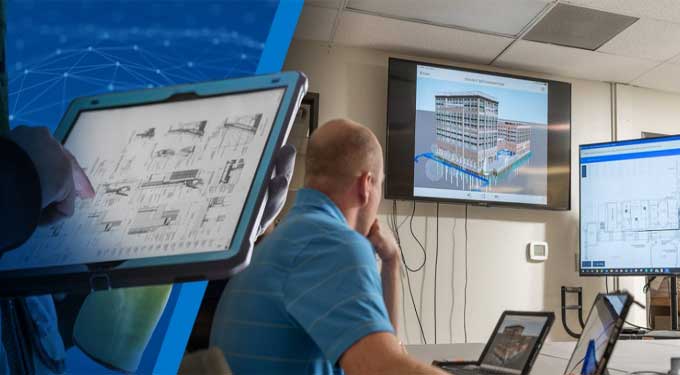Top 10 Benefits of Revit
Tweet
If you are using CAD for building design, then you focus on creating drawings. User is using BIM (building information modeling), for creating a building model, and then the drawings can be generated from the model.
Autodesk Revit is a type of BIM design software used by the architecture, engineering, and construction (AEC) industry. It is one of the most popular BIM solutions. Revit moves on simple 2D drawings and amenities the 3D modeling. Architectural documentation, structural, and MEP systems are for project?s lifecycle from the early stages design through construction.
Revit and its Benefits
1. Parametric Modeling
The 3D models creation from a set of rule referenced with all inclusive phrases is called Parametric Modeling. Parametric modeling is used by Revit. Part of ?family? is everything in Revit, from title blocks to 3D views to building components such as walls or floors. Some build into the software, some accessible through libraries. Assigning dimensions and properties to 2D or 3D information creates a family. A Revit user can modify by changing those parameters (for example, height, width, or door thickness door family). That gives Revit models greater control over building design.
2. Automation
Using all information in a single database creates a Revit model house. It means that whenever you make a change in the model, the database gets updated. The changes are carried throughout the entire model, enabling automation and making the building design process more efficient to eliminate some of the rework that comes with ?chasing? changes around our various project files.
3. Collaboration
One of the more distinct differences between Revit and AutoCAD permits multiple users to work in the same Revit model at the time, as opposed to AutoCAD, where only one user can make changes to a .dwg file once at a time. Using the ?Sync with Central? tool in Revit, users can push their model changes to a ?Central? model while also pulling any changes from that same ?Central? model that is made by colleagues into their ?Local? copy of the model. The project team enables full collaborative functionality to this process.
The interoperability of Revit with other Autodesk software, such as AutoCAD or FormIt, along with the extensive plug-ins creates by other software companies and applications. It helps facilitate collaboration between multiple teams and disciplines as well.
4. Coordination
Whether coordinating models as part of the architectural design process or performing constructability reviews from users in the construction industry, Revit provides numerous main tools for coordination between different models, file types, disciplines, and trades. Revit Tools permit users to monitor changes from a linked model, review notifications of those changes, copy elements from a link model into their base model, and speak those matter that need a resolution to other teams working on the same project.
5. Scheduling
Revit model is functioning as a single database of all information in a model. Revit Scheduling cuts down on the time traditional workflows demand. The Revit model changes schedules that have set up will instantly update with those changes, streamlining one of the more time-consuming processes in the architectural design process.
The Schedules can export out of Revit, modified, then imported back in with those changes to help with project management.
6. Energy Analysis
Design of sustainable is very important in the design and construction process these days, and feature of Revit has several analytical tools that can help measure the environmental impacts of your building design. Specifically, the ?Energy Optimization? tools build into Revit (as well as additional plug-ins available), in conjunction with ?Insight 360? in the cloud. Designers can visualize the impact their design could have at any phase of the design process without the need to create a new model or using other software.
7. Rendering Presentation
Software multiple pieces are using for rendering and presentation materials is a time-honor process in the design industry. Revit gives specific tools to create these materials all in one platform. While 3D modeling programs such as 3ds Max are more useful for some of the animation industry, the ability to create 3D drawings and renderings directly in Revit, rather than import your model into a different item of software, saves little a bit of time. Revit provides tools like 2D presentations and 3D visualization deliverables using Revit?s extensive material libraries and rendering plug-ins.
8. Construction Documentation
- Revit is utilizing its 3D modeling capabilities and coordination tools. Users can quickly analysis clash detection and recognize other coordination issues. With these changes, and in conjunction with the dynamic nature of how changes populated throughout an entire model, users can generate high-quality, coordinated, and error-free construction documents rather quickly.
- Additionally, the Revit project templates creation and use will maintain consistency across your team?s construction documentation. It is keeping project delivery uniform across all projects in your office.
9. Drawing Sheet Set-Up
Because all information intelligently connected in Revit, changes made in one view carries through to another. For example, if I move a wall in a floor plan that will automatically be updated in other floor plans, sections, perspectives, etc. When views drop onto a sheet, users can assure that changes no longer need to be chased around an entire drawing set housed within multiple files. Instead, the user makes a one view change and can confidently print the drawing set right away, knowing that the waterfall of changes tied to that one edit will automatically carry through the entire drawing set.
10. Cloud-Based Access
Due to pandemic, remote work is the new normal not necessary for many offices. Revit model housing in the cloud gives access anytime and from anywhere to your Revit models. There are lots of cloud-based platforms that can work with Revit. This cloud connection extends the Revit power and its collaborative capabilities.

Gallery
Feel free to contact us for BIM requirements. One of our representative will respond you within 24 Hours. Send us your projects requirement today and grow your project.
Explore More !







